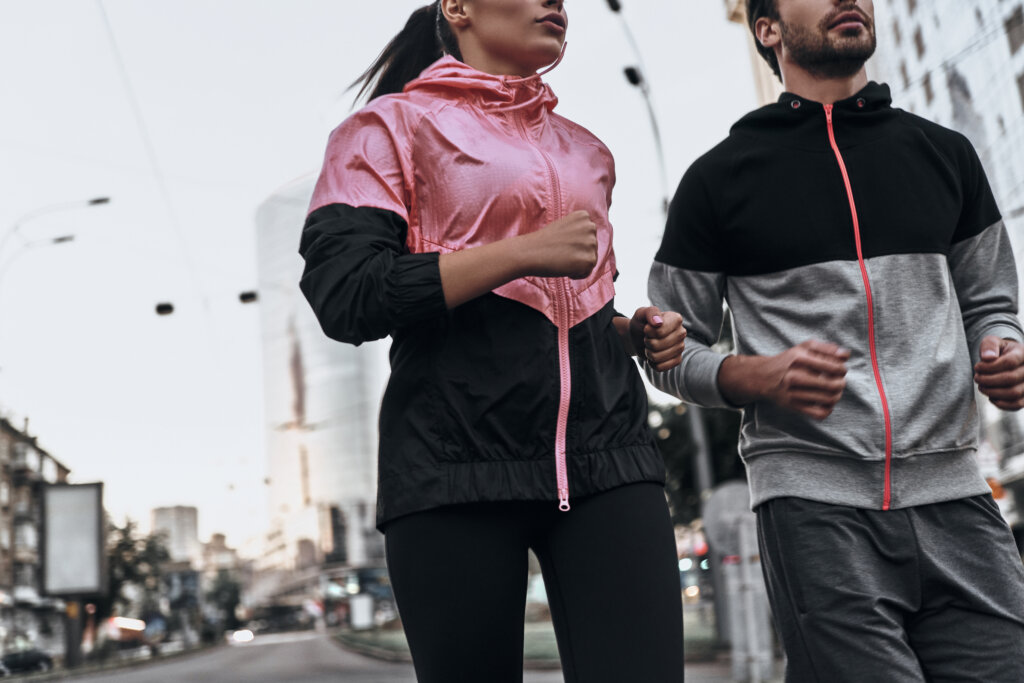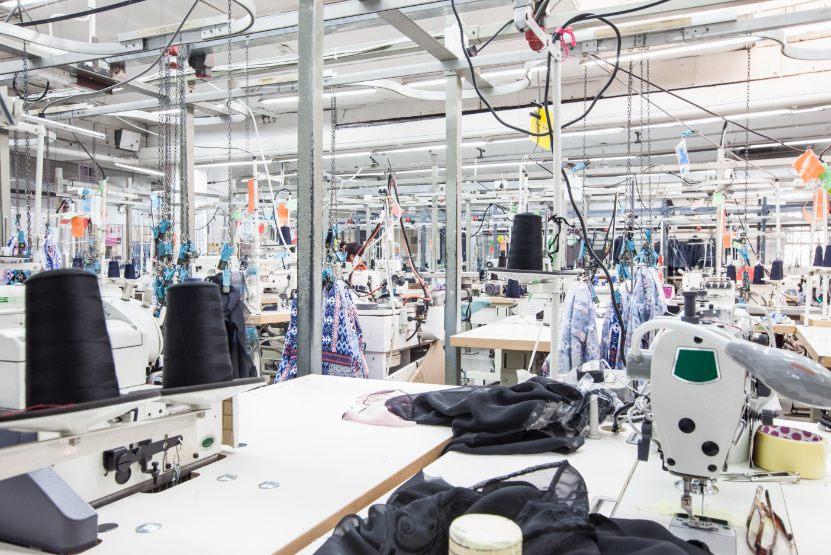The best option for anyone wishing to dress up their casual clothing is a tracksuit. A properly fitted tracksuit may offer plenty of comfort and style, whether you’re lounging around the house, running errands, or going for a run.
Clothing businesses and manufacturers have stepped up their efforts to create and promote customized warmups because the garment market is large and continuously evolving along with fashion trends. Custom tracksuit manufacturers manufacture custom suits for start-ups and clothing brands using several tracksuit fabric types, such as nylon, polyester, polypropylene, spandex, bamboo, cotton, and wool.
To show you how to start a fitness clothing line and choose the ideal tracksuit fabric that best meets your demands and tastes, we will go over the various factors to take into account in this article.
What is Tracksuit Fabric?

Certain characteristics of tracksuit fabrics make them perfect for physical activity. The purpose of a tracksuit is to keep muscles warm when exercising and to protect against the weather. It consists of two pieces: loose-fitting, relaxed-fitting pants and a jacket that zips or pulls over. Comfortable and generally moisture-wicking, tracksuit material draws perspiration away from the body to provide a comfortable workout. It is also effortlessly cared for.
Tracksuit styles, on the other hand, come in a wide variety and are intended for use in various situations and climates. All of them, from waterproof to warming fleece tracksuits, are made to improve your performance when working out or in the great outdoors. Having said that, premium tracksuit fabric choices are still a staple of everyday wear since they are still fashioned from the same materials for tracksuit manufacturing that first brought them fame.
History of Tracksuit
The tracksuit was once thought to have been invented in the 1930s, but Adidas’s first article of clothing in the late 1960s gave it a major boost. Over many years, tracksuits have gone in and out of style. The 1960s and 1970s saw the rise of tracksuits as sportswear that was appropriate to wear outside of the gym. In 1975, tracksuits made of cotton, polyester, terry cloth, or a combination of materials gained popularity. Velour shot to popularity in the late 1970s and became the most popular type of durable fabric for tracksuits. Wearing sportswear remained popular well into the early 1980s. Nylon shellsuits finally superseded tracksuits as the preferred option in the late 1980s. This pattern only persisted for a few years.
Men’s and women’s tracksuits returned to mainstream fashion in the late 1990s. They went back to 1970s textiles, especially polyester. Velour made a resurgence in the 2000s, thanks to businesses like Juicy Couture, which continued the trend. For the majority of the decade, this persisted. After a brief hiatus in the late 2000s, tracksuits made a comeback with the “athleisure” movements of the 2010s.
Tracksuits were first linked to UK grime music and its attendant lifestyle in the early 2000s. The mainstream media has consequently linked the fashion sense to the nation’s gang culture, even though grime artists like Stormzy have publicly distanced themselves from it.
Athletes from different Olympic teams, typically all representing the same nation, have been asking renowned fashion designers to create tracksuits for them since 2006. Ralph Lauren, for example, created the American team’s clothes for the 2010 Winter Olympics opening ceremony. For the first time in the history of the games, a top fashion designer created the uniforms for a specific nation’s team in every competition for both the Olympic and Paralympic Games when Stella McCartney was appointed Creative Director for the 2012 GB Olympic Games by Adidas.
What Fabric are Tracksuits Made From?

The “space age” period of the 1960s saw the creation of the tracksuit, which was mostly worn for sports and involved a combination of synthetic nylon textiles. The textiles used in this garment were selected based on a variety of factors, including their ability to be worn for exercise. Each type of fabric is made differently, resulting in variations in weight, handling, and surface texture. Different weaving techniques will be used to produce a range of textures, structures, and transparency levels. Synthetic fabrics are created using chemical procedures, whereas natural fabric sourcing is generated exclusively from natural yarns.
Tracksuit materials are usually knitted because they have an amazing amount of elasticity, which lets you move freely while working out. For instance, knitted materials with a liberal give, including velour, scuba, and jersey, are perfect for tracksuit construction. Furrowed surfaces and piles of loose material make very good thermal insulators because the heated air is trapped in the pile.
Factors to Consider When Choosing Tracksuit Fabric
It’s important to comprehend the elements that affect the selection of material for a tracksuit before delving into the different kinds. These consist of:
- Comfort: During strenuous activity, the material should feel soft on the skin and not irritate or hurt.
- Breathability: Controlling body temperature and avoiding excessive sweating depend on something having good breathability.
- Wicking away moisture: Whether you’re working out or just lounging about, materials that do this keep you dry and comfortable.
- Sturdiness: The types of sportswear fabric should be able to tolerate many washings and wearings without losing their color or form.
- Flexibility and Fit: The material needs to be well-fitting without being excessively tight or loose, enabling a complete range of motion.
- Climate and Weather: Take into account the usual weather in your location or the area where you plan to wear the tracksuit most of the time.
What Fabric is Used for Tracksuits?

The type of material used in tracksuits has a significant impact on how well they function and feel overall. There are many different types of high-quality tracksuit fabrics used to make tracksuits, and each has special qualities. Let’s examine the 12 kinds of tracksuit materials in detail and what makes them unique.
Nylon
One synthetic material that is strong, lightweight, and elastic is nylon. Nylon tracksuit fabric dries rapidly, repels water, and is abrasion-resistant; it is suitable for tracksuits and other activities that call for flexibility and durability, such as outdoor sports. They are perfect for tasks that require a lot of bending and stretching since they offer a great range of motion.
Polyester
Another common material for tracksuits is polyester. It has good moisture-wicking tracksuit material qualities, is a lightweight fabric, and dries fast. It also doesn’t shrink or wrinkle and it is easy to maintain due to its durability. Polyester tracksuit fabrics are ideal for all kinds of physical activity and are available in a variety of textures, including brushed and smooth.
Spandex
Stretchy and comfortable tracksuit materials: Spandex is the ideal material for tracksuits since it adds flexibility. It is perfect for intense exercises and sports because it is lightweight tracksuit material, is breathable, and dries fast. Since spandex mixes very nicely with other materials, it’s frequently used to improve the performance of materials like cotton, polyester, or nylon.
Cotton
Cotton’s inherent softness and breathability make it a popular fabric choice for tracksuits. It is perfect for exercise and strenuous physical activity because it is long-lasting, low-maintenance, and absorbs moisture. Cotton-breathable fabrics for tracksuits are available in various weight and thickness options, so you may select the ideal one for your requirements.
Fleece
A popular option for chilly weather or sitting around is fleece tracksuit pants. Synthetic materials like fleece offer warmth and insulation without piling up. It feels pleasant against the skin and is lightweight and supple.
Tencel
Wood pulp is used to make tencel, a fiber derived from wood. This cloth has a nice texture and the ability to wick away perspiration because it is composed of hardwood fibers. Tencel is an environmentally beneficial material because it is fully biodegradable. This fabric is wrinkle-free and maintains its coolness.
Wool
In colder climates, wool makes an excellent tracksuit material. Woolen fabrics help keep you warm by retaining heat in their fibers. The woolen fabric has no smell when used for sportswear because it breathes well.
Polypropylene
Polypropylene is a fabric composed of plastic. But because of this fabric’s total water resistance, the interior of your clothes will remain dry even if perspiration gets on the outer layer. Both on its own and as a foundation layer for other fabrics, this material is versatile.
Gore-Tex
Gore-Tex is a composite material used to produce running shoes as well as tracksuit apparel like jackets. It is a fabric coating that is typically applied to sportswear to make it waterproof and breathable. Notwithstanding this characteristic, it remains a breathable textile that is suitable for high-intensity activities. Essentially, it allows perspiration to drain while keeping water and wind outside. That makes this material a fantastic option for windcheaters.
Synthetic
To relieve athletes of the burden of wearing rubber and plastic sportswear that would otherwise cause them to overheat, synthetic material was invented. Synthetic materials can be utilized for tracking devices like knee and elbow bands, in addition to apparel. To keep you cool, this material is breathable and rapidly absorbs perspiration.
Bamboo Fiber
Another option for an environmentally friendly material is bamboo fiber, which is created naturally. Because bamboo fiber wicks away moisture and is incredibly light, it makes for odorless sportswear. When you participate in outdoor sports, bamboo fiber also offers incredible UV protection.
Microfiber
As the name implies, microfiber is a substance composed of minuscule thread fibers with a linear density of no more than one denier. This indicates that the threads in microfiber are 100 times finer than those in human hair. It is man-made rather than occurring naturally. Polyester comes in a variety of forms to create microfiber. As a result, microfiber is a costly material that is frequently seen in name-brand sportswear.
How do You Choose the Right Fabric for Your Needs?

Selecting the appropriate material for your tracksuit is essential for optimal comfort and functionality. Because of its softness and breathability, cotton is a popular material, but because it absorbs sweat and gets heavy, it might not be the best choice for vigorous exercise. Conversely, polyester tracksuit materials are perfect for activities requiring a lot of movement because they are lightweight and moisture-wicking. Another strong and quick-drying material is nylon, and spandex-blend tracksuits offer elasticity and flexibility for a close fit. Before making a choice, think about the activity you’ll be performing and the weather you’ll be in. In the end, the clothes you select will depend on your unique demands and tastes.
What is the Most Comfortable Material for Tracksuits?
Nylon or polyester blends are typically used to make tracksuits. Seek materials that are breathable, light, and soft. An amalgamation of spandex and polyester is the ideal material for a tracksuit. This combination offers the ideal balance between comfort and durability.
While working out, tracksuits should provide you with the comfort and adaptability you require. Whether you choose to play basketball, football, or just regular activities, a tracksuit can help you get the most out of your comfortable body movement.
FAQs
How do a Tracksuit and a Sweatsuit Differ from one Another?
Sweatsuits are intended for casual events and leisure use, in contrast to tracksuits, which are mostly connected with sports. A “sweat suit” is usually a coordinated pair of clothes that includes sweatpants, a hoodie, and a sweatshirt.
Why is a Tracksuit Called a Tracksuit?
Wearing a tracksuit for casual or exercise use consists of loose, warm pants with an elastic or drawstring waist and a loose jacket or sweatshirt with a front zipper.
Who Popularized Tracksuits?
The tracksuit was originally designed as attire for lounging around the house or working out, and it was dubbed “The Sunday Suit.”. However, when the tracksuit was introduced in 1967, it was Adidas that turned it into a cultural symbol. Adidas was a well-known brand at the time, but it was a shoe firm alone.
Are Tracksuits Fashionable in 2026?
This comeback is a component of a larger movement known as “athleisure,” in which clothes meant for the gym are worn for social events, business, or educational purposes. Tracksuits’ unrivaled comfort is one of the main factors contributing to their popularity in 2026.
Conclusion
Selecting the ideal performance tracksuit fabrics for your custom tracksuit is an important choice that affects performance, comfort, and brand identification. You can make a unique tracksuit that fits your needs and sticks out from the crowd by investigating customizing options, thinking about various fabric selections, and analyzing your preferences.
We at Tack Apparel take great satisfaction in being the leading location for the production of personalized tracksuits. With years of experience and a committed group of experts, we provide unmatched knowledge and assistance to help you take your brand to new heights.




